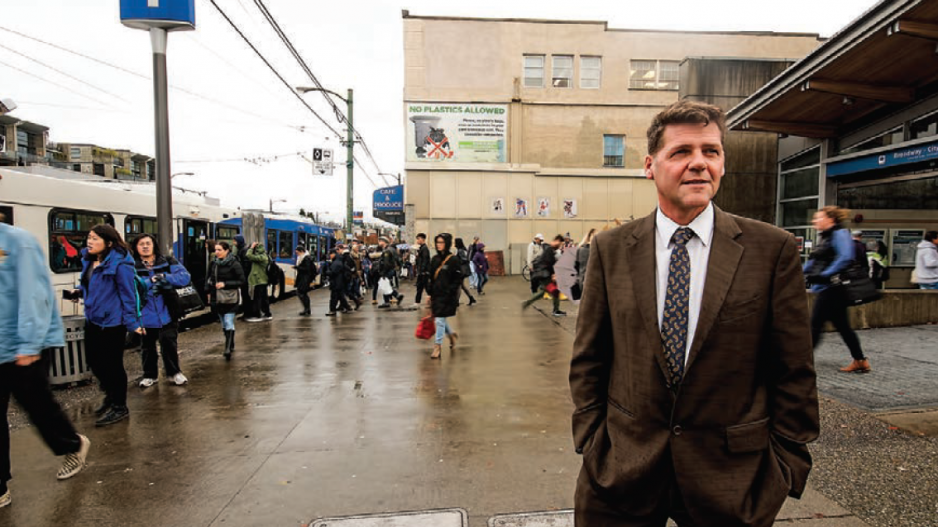The past 12 months “could be characterized as the year of the second opinion when it comes to transportation futures for the region,” said Anthony Perl, a professor of urban studies and political science at Simon Fraser University.
But 2018 could bring a thaw in the long winter that has frozen in place plans for major public transit infrastructure projects in Greater Vancouver.
Perl said that while multiple major projects inched forward, 2017 will likely go down as a year when Lower Mainlanders were forced to hurry up and wait.
While both the City of Vancouver’s proposed Broadway subway line and the City of Surrey’s light-rail transit lines got tentative green lights from the federal government for a 40% funding share, they are now waiting on various approvals from the new provincial BC NDP-BC Green Party coalition government.
The BC Liberal Party promised to introduce ride-hailing as part of its election platform but was defeated, and the new coalition government isn’t expected to bring a report to the public until 2018.
The George Massey Tunnel Replacement Project is under an independent technical review, and the report won’t come through until next spring, according to TransLink’s website.
TransLink also promised a new Pattullo Bridge to replace the 80-year-old structure, but it’s not scheduled to open until 2023. So far the only thing commuters on the Fraser River causeway will have noticed is the constant delays caused by construction work to rehabilitate the aging bridge.
TransLink has recently gone to the public asking for feedback on distance-based fare pricing, but results from the survey aren’t expected until 2018.
And while TransLink has launched its ambitious 10-year vision, only the first of three phases has been approved by the Mayors’ Council on Regional Transportation. The plan looks to accommodate a region that expects to welcome more than one million new residents and 600,000 new jobs over the next three decades.
Possibly the only substantial change British Columbians might have noticed this past year, other than increased bus service, new pedestrian and bike lanes and highway upgrades, is the lifting of the toll on the Port Mann and Golden Ears bridges.
In fact, the only transportation infrastructure project that appears to be on schedule is the new Canada Line station at Capstan Way in Richmond, in which real estate developers privately ponied up $3.5 million for TransLink to get the ball rolling on design work. The money comes with a stipulation: the station must now be completed within 30 months.
According to the Greater Vancouver Board of Trade’s 2017 provincial election platform survey, the No. 1 issue for the business community is transit and transportation, and the top two issues within that subset are rapid-transit expansion for Surrey and Langley, and the City of Vancouver’s Broadway subway line extension.
Lon LaClaire, director of transportation for the City of Vancouver, said the main priority is to learn lessons from the construction of the SkyTrain Canada Line along Cambie Street, which he acknowledges caused multiple headaches for people who lived and owned businesses along the road.
“A lot of the criticism on the Canada Line for Cambie was that construction of the project wasn’t well mitigated, and businesses suffered as a result of that,” LaClaire said.
The Broadway subway line extension would start at the VCC-Clark station in Strathcona, and run west all the way to Arbutus Street on West Broadway. There are six tentative stops, the most notable being one that would link up with the Broadway-City Hall SkyTrain station.
Perl said the Broadway subway extension’s potential impact on residents and businesses along the line comes down to one thing.
“The acid test is going to be in three words: deep-bore tunnel,” he said. “If there is a deep-bore tunnel, then the disruption will be manageable. If it’s going to be cut-and-cover, that’s what destroyed the Cambie line development. So it’s pretty simple.”
The Canada Line along Cambie was built using the less expensive cut-and-cover method, which resulted in a class-action lawsuit by individuals and businesses who felt unduly disturbed by the process. As far back as 2014, Vancouver Mayor Gregor Robertson pledged the Broadway line will be built using bored-tunnel construction, which is more expensive but does not disrupt businesses and traffic nearly as much.
LaClaire said the city has been been working with TransLink for about a decade on the project, and he said this year’s change in provincial government in B.C. has given the city renewed optimism.
“If anything it looks more promising,” LaClaire said. “The Liberal government, they seemed to be just really quiet and silent in terms of non-support for massive transit investment in the region. If anything they were kind of putting up a lot of roadblocks and trying to make the [Mayors’ Council] do this and that.” The Mayor’s Council would comply, he said, but the provincial government “wouldn’t follow through on their part.”
LaClaire said the city is working on getting procurement ready while it waits for a specific funding announcement from the provincial government and then a final endorsement from the regional Mayors’ Council. He noted the subway line extension is a two-phase plan, the second being an extension of the line to the campus of the University of British Columbia, something he estimates could start preplanning within a decade. •




